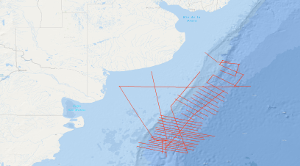From 24th November 1998 to 24th February 1999 BGR in cooperation with YPF (Yacimientos Petrolíferos Fiscales) and SHN (Servicio de Hidrografía Naval) conducted three seismic surveys along the passive continental margin of Argentine. The seismic vessel M/V Akademik Lazarev which is operated by SMNG (Sevmorneftegeofizika) was used for these cruises. Although the seafloor spreading history of the South Atlantic Ocean is very well defined, the development of the continental margins poses still great problems to a profound understanding. When break-up of Gondwana started in Middle Jurassic, South Africa and South America remained connected. Their break-up started in Early Cretaceous, possibly propagating from south to north. Before break-up, huge tholeiitic flood basalts were extruded near the future rift, namely the Paraná basalts in Brazil and the Etendeka basalts in Namibia. It is likely that these basalts are caused by a large mantle plume. As the flood basalts were predecessors to the break-up, often a causal relationship is assumed. The dipping reflector sequences along large parts of the continental margins of South America and South Africa are interpreted as indications of the plume influence. Investigations along many passive margins have meanwhile shown that dipping reflector sequences exist along most of them. These so-called volcanic margins are the normal ones, the non-volcanic margins are the exception. For many years, it had been assumed that the hydrocarbon potential of volcanic margins is very low. The discovery of the Kudu gas field has demonstrated that this assumption is not valid in general. This increases our interest in continuing the investigation of volcanic passive margins and the variability of their structure along strike. BGR has carried out already two marine geophysical cruises off Argentina, namely with M/V EXPLORA in 1985 and with FS SONNE in 1993. These surveys had shown locally the existence of threefold dipping reflector sequences (Hinz et al., 1999). Furthermore, it had turned out that not everywhere they are accompanied by the strong magnetic G anomaly (Rabinowitz & LaBrecque, 1979). The main objectives of the BGR98 cruise were: (1) Investigation and mapping of the zone of the seaward dipping reflectors (SDR) (reflection + refraction seismic) (2) Investigation of the sedimentary column within this zone (reflection seismic) (3) Setting up a seismostratigraphy based on the seismic records obtained during the cruise and the information from the previous cruises (BGR87, SO85) as well as on additional well information (4) Comparison of the argentine seismic data with seismic data of the conjugate volcanic margin off Namibia (BGR 87). The study area is located offshore Argentine, extending from about 37° 20' S to 45° 40' S and from about 61° 10' W to 52° 00' W. It comprises the Colorado Basin as well as the outermost shelf, slope and rise of the continental margin with water depths up to 5000 m. In der Zeit vom 24.11.1998 bis 24.02.1999 hat die BGR drei Expeditionen im Bereich des argentinischen Kontinentrandes durchgeführt. Kooperationsparter hierbei waren YPF (Yacimientos Petrolíferos Fiscales) und SHN (Servicio de Hidrografía Naval). Als Plattform für die Arbeiten diente das Seismik-Schiff MS Akademik Lazarev von SMNG (Sevmorneftegeofizika). Obwohl viele Details der ozeanische Entwicklungsgeschichte des Südatlantiks bekannt sind, ist der Prozess des initialen kontinentalen Aufbrechens noch weitgehend unverstanden. Beim Zerbrechen von Gondwana im mittleren Jura waren Südamerika und das südliche Afrika noch verbunden. Hier begann das Aufbrechen in der frühen Kreide und setzte sich von Süden nach Norden fort. Vor dem Aufbrechen wurden großräumig Flutbasalte abgelagert – die Parana-Basalte in Brasilien und die Etendeka-Basalte in Namibia. Die Ursache dieser Basalte wird im unteren Mantel vermutet. Als weiteres Anzeichen dieser magmatischen Anomalie finden sich seewärts einfallende Reflektorfolgen sowohl am südamerikanischen als auch am südafrikanischen Kontinentrand. Diese Reflektorfolgen finden sich weltweit an einer Vielzahl passiver Kontinentränder, so dass der vulkanisch geprägte passive Kontinentrand als der Normalfall zu betrachten ist. Generell wurde das Kohlenwasserstoff-Potential von vulkanischen Rändern als gering eingestuft. Die Entdeckung des Kudu-Gasfeldes vor Namibia zeigte jedoch, dass diese Aussage nicht generell gültig ist. Diese Tatsache ist Ausgangspunkt für die von der BGR durchgeführte systemtische Erkundung ausgewählter vulkanischer Ränder. Vorhergehende Forschungsarbeiten vor Argentinien wurden 1985 mit MS Explora und 1993 mit FS Sonne durchgeführt. Diese Untersuchungen zeigten, dass die seewärts einfallenden Reflektoren in drei Sequenzen unterteilt werden können, und das die begleitende magnetische G-Anomalie unterschiedlich stark ausgeprägt ist. Die Hauptarbeitspunkte der Untersuchungen in 1998/1999 waren: (1) Detaillierte Kartierung der Zonen mit seewärts einfallenden Reflektorfolgen (SDRs) (2) Abbildung der sedimentären Säule (3) Entwicklung eines darauf aufbauenden seismostratigraphischen Prinzips (4) Vergleich zum konjugierenden Kontinentrand vor Namibia Das Untersuchungsgebiet vor Argentinien erstreckt sich von 37° 20' S bis 45° 40' S und von 61° 10' W bis 52° 00' W. Es enthält sowohl das Colorado Becken als auch den äußeren Schelf und erstreckt sich über den Kontinenthang bis hin zu Wassertiefen von 5000 m.





